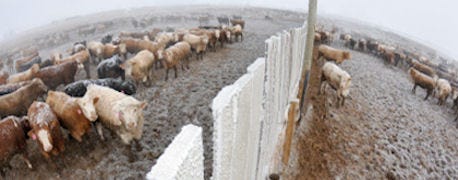January 13, 2015

The dramatic drop in corn prices may have some cattle producers thinking about exchanging their high protein forage supplement with corn. This is not a good idea, says Ken Olson, professor and SDSU Extension beef specialist.
"Unfortunately, high-energy, low-protein feedstuffs do not stimulate the positive responses in fiber digestion by ruminants that a protein supplement does. In fact, with feedstuffs that are high in starch, meaning any kind of grain, we typically see a negative effect on fiber utilization," Olson says.
The negative effect occurs for two reasons.
First, adequate protein is not provided to the rumen microbes to stimulate growth of fiber-digesting microbes.

Rations for cows in a winter lot need to be carefully managed. Don't be tempted to replace high protein protien forage supplement with cheaper corn. Photo: SDSU Extension
Second, inclusion of starch from grain-based supplements interferes with fiber digestion.
"Rumen microbes will preferentially digest the starch before they digest fiber, so fiber digestion actually decreases. Also, at higher levels of grain, rapid fermentation of the starch lowers rumen pH, which is harmful to the fiber-digesting bacteria," Olson says.
Once there has been a negative effect on fiber digestion, the subsequent effect is reduced forage intake. Olson explained that this is because there are two aspects of digestion that are negatively impacted, both the total amount of forage that is digested and also the rate at which it is digested.
"Once the rate of digestion slows down, then passage of feed out of the rumen is slowed. Forage intake cannot occur at a rate faster than the rate at which forage disappears from the digestive tract, whether by digestion or passage. Thus, if starch-based supplements slow the rates of both digestion and passage, then they will also reduce forage intake."
In general, Olson says relatively small amounts, less than 10% of diet dry matter, of starch-based supplements can be fed with little or no negative effect on forage utilization. However, the negative effects escalate in proportion to the level of supplemental grain beyond that.
"Typically, cows in moderate or higher body condition should be able to maintain themselves on dormant range with adequate protein supplementation," Olson says.
But what if cows are thinner than desired and gaining condition before calving is a goal? Providing energy so they can gain weight would seem desirable, but grain-based supplements usually won't give the desired results because of the negative effect on forage utilization.
Under these circumstances, introducing byproducts that contain readily digestible fiber is a viable alternative to add supplemental energy to the diet.
Two common feedstuffs that fit this scenario are soybean hulls and sugar beet pulp. "Both have levels of energy and protein that are nearly the same as feed grain, but contain primarily fiber and little starch," he says.
Even without the negative effect of starch, these energy feedstuffs still have limitations so Olson says they should not be fed at excessive levels. "First, they still do not provide adequate supplemental protein. Second, while they don't necessarily decrease fiber digestion, high levels of inclusion in the diet still means they take space in the rumen and act more as a substitute than addition to the forage in the diet," he says.
The bottom line, when it comes to supplementing low quality forages is to remember that protein is the first limiting nutrient in utilization of low-quality forages.
"Supplementing protein not only improves the protein status of the cow, but also her energy status. Energy supplements should only be considered on a limited basis and as an add-on after supplemental protein has been provided," he says.
The only exception to this recommendation is if the goal is to purposefully substitute grain for forage to limit the amount of forage that a cow consumes.
This may be the case if pasture is limited and expensive, but grain is cheap and plentiful. This is currently the case for some producers, considering that pasture rents are currently high relative to corn and other high-energy concentrate feeds.
Olson said caution should still be implemented when feeding energy concentrates to avoid digestive disorders in ruminant animals, particularly acidosis and founder.
The concentrate feedstuff should be introduced to their diet at a low level, 10 to 20 percent of diet dry matter and gradually increased to allow the rumen to adapt.
For more information, contact Olson at 605-394-2236 or [email protected].
Source: SDSU Extension
You May Also Like




